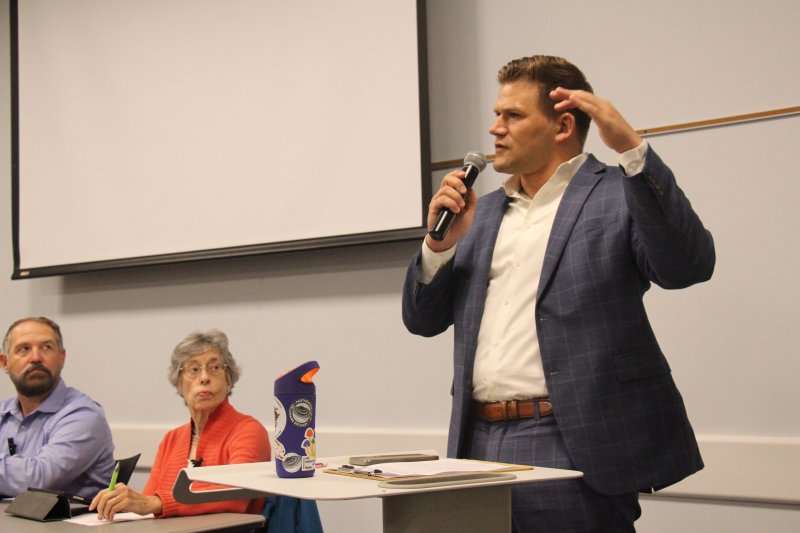Sussex panel nears vote on growth-control rules

A group created by Sussex County Council to propose rules to curb an ongoing housing development boom reviewed the final draft Aug. 21 in anticipation of a Thursday, Sept. 11 vote.
Andrew Bing, a consultant with Kramer & Associates, explained at the end of the meeting that group members will be asked to rank each of 19 recommendations using a five-choice scale: strong support, support, I can live with it, oppose or strongly oppose.
Results of the opinions from the 10-member land-use reform working group, which has been meeting since June, will be tabulated and sent to Sussex County Council for consideration.
“We have to find a way to balance these competing interests,” said Mike Riemann, a representative of the American Council of Engineering Companies who serves on the working group. “Trying to find a way to balance these in a way that’s productive is what I think these recommendations do when taken holistically together.”
Some changes could be accomplished quickly, while others would require more time to amend county laws and be included in the county’s next comprehensive land-use plan update that is due by the end of 2028.
A common complaint in recent years is that development in Sussex County does not follow State Strategies for Policies and Spending, which outline where the state plans to invest in infrastructure. The result is that nearly a quarter of new houses are scattered in rural areas, leaving the state to catch up with development. Some working group recommendations are intended to bring county and state plans closer together.
One concept that much of the working group’s planning revolved around was creation of growth zones, areas where denser development with more housing options would be encouraged. Concentrating development near where it already exists and is supported by infrastructure would reduce sprawl and subsequent harm to the environment while preserving farmland and open space.
While the working group outlined criteria that can be used to establish the boundaries of growth zones, it will be left to county council to determine where to draw the lines.
Vince Robertson, an assistant county attorney, said establishing growth areas could take more time than any other suggestion from the working group.
A provision in the county zoning code that dates back to its creation in the 1970s allows up to two homes per acre over vast areas of the county, which some complain contributed to sprawl when the housing boom began.
The working group will consider proposing to reduce that to one house per acre outside the growth zones, where conservation of farmland and open space would be encouraged. There was disagreement over whether that change would reduce or increase sprawl.
A related concern is that reduced density would devalue rural land outside growth areas. The conflict between those two competing interests was a point of contention at the Aug. 21 meeting.
Working group members insisted on providing specific advice, wherever possible, to give council guidance.
The movement to overhaul housing development rules has been growing as sprawl into rural areas has overburdened roads, schools, emergency services, medical providers and the environment.
A backlash in the community was felt at the ballot box in November, when three newcomers calling for change defeated incumbents and took a majority on the five-member Sussex County Council.
Soon after beginning his term, Councilman Matt Lloyd called for a moratorium on review of new large-scale housing development proposals while new rules to control growth were drafted. Lloyd’s suggestion failed to win support from other council members and drew a significant protest from developers, builders, real estate agents, contractors, chambers of commerce, Beebe Healthcare and others.
As council set its goals for the year, it decided to form the working group to begin the process of creating rules to control growth.
The panel was asked to create rules to:
- Implement smarter, sustainable development
- Ensure growth is supported by infrastructure
- Address affordable/workforce housing needs
- Preserve farmland and natural resources
- Prevent low-density, uncoordinated sprawl.
A report to be written based on the working groups’s recommendations will document the process that led to the proposals, but it won’t provide details of the positions of members as the plan was crafted, Bing said.
“We want to document, not editorialize,” he said.
The group's final meeting is scheduled for 10 a.m., Sept. 11, in the county Public Safety Complex, 21911 Rudder Lane, Georgetown.
The group’s progress was the topic of a roundtable discussion hosted by the Sierra Club later in the day Aug. 21, which included former Delaware Department of Transportation Secretary Anne Canby and working group members Riemann; Jill Hicks, president of the Sussex Preservation Coalition; and Christophe Tulou, executive director of the Delaware Center for the Inland Bays.
Reimann noted Transportation Improvement Districts created by the state have done a lot to create cohesive infrastructure projects in areas affected by development, in which developers fund roadwork.
“It just allows for those improvements to be planned better,” he said.
Current transportation planning contributes to congestion by expanding roads, said Canby, a leader of Rethink Delaware, which hopes to sway state leaders on a wide range of interrelated issues, including housing, transportation and the environment.
She faulted Transportation Improvement Districts, which were first implemented after she left office, for dealing almost exclusively with road improvements and not other modes of transportation.
“It’s not really balancing out and spreading the trips across multiple modes,” she said. “You can keep building more roads [but] it’s like letting the belt out on a fat person; you’re really not making a lot of progress. It fills up and then you have a bigger problem. And Route 1 is a good example.”
Working group recommendations
The 19 recommendations expected to be presented for votes by the Sussex County Land-Use Reform Working Group are:
- Align future land-use map. As part of the preparation of the next county comprehensive land-use plan scheduled to be completed by the end of 2028, the county should revise the map using the State Strategies for Spending as a guide. The changes should designate boundaries of the growth areas and conservation areas
- Establish growth and conservation areas. There were suggestions for criteria to be used to determine boundaries of growth zones, which kinds of zoning would be allowed in each zone and protections for conservation districts
- Comprehensive rezoning through the county comprehensive plan, enabling housing diversity and affordability
- Establish clear standards for reviewing requests for rezoning, consistent with the comprehensive plan, compatibility with zoning district intent, environmental suitability of the site and proximity to existing or planned supportive infrastructure
- More clearly define “missing middle” housing types that are lacking in the county
- Permit “missing middle” housing in strategic areas, making it easier to build in growth areas the duplexes, triplexes, townhomes, cottage courts, stacked flats and multifamily buildings that would fill housing needs
- Establish bulk and setback standards for “missing middle” housing and adjust height, building length and separate caps in growth areas. Details were proposed in the suggestion
- Strategic density adjustments to promote growth in targeted areas and discourage development in conservation areas. That includes per-acre maximums of one unit in AR-1 zoning districts, four units in GR zoning districts, six units in MR districts and 18 units in HR districts
- Develop strategic density bonus program to create incentives to preserve open space, farmland, natural resources and affordable housing. Sussex County Preservation Program would allow greater density in growth areas in some zoning districts in exchange for a fee that would preserve farmland, forest and high-value natural resources in conservation areas. The Sussex County Purchase Program would allow greater density in some zoning districts in growth areas in exchange for creation of affordable housing
- Amend the county rental program to make it more attractive for developers to include such housing in developments
- Create transportation improvement districts for all growth areas and develop a transportation impact fee for development in conservation areas
- Complete adoption of the drafted master plan zoning ordinance for large-scale development
- Forest preservation
- Encourage naturalized landscaping in passive open space
- Focus subdivision design around conservation priorities
- Support working farms through permitted agricultural support uses outside growth areas, such as allowing processing facilities and equipment repair businesses
- Explore a transfer of Development Rights Program. Homebuilders would buy development rights in conservation areas, which would allow them to build in growth areas
- Improve clarity and consistency of Subdivision Code Section 99-9(C) standard
- Prioritize hearing scheduling for projects that advance county land-use goals.
Kevin Conlon came to the Cape Gazette with nearly 40 years of newspaper experience since graduating from St. Bonaventure University in New York with a bachelor's degree in mass communication. He reports on Sussex County government and other assignments as needed.
His career spans working as a reporter and editor at daily newspapers in upstate New York, including The Daily Gazette in Schenectady. He comes to the Cape Gazette from the Cortland Standard, where he was an editor for more than 25 years, and in recent years also contributed as a columnist and opinion page writer. He and his staff won regional and state writing awards.
Conlon was relocating to Lewes when he came across an advertisement for a reporter job at the Cape Gazette, and the decision to pursue it paid off. His new position gives him an opportunity to stay in a career that he loves, covering local news for an independently owned newspaper.
Conlon is the father of seven children and grandfather to two young boys. In his spare time, he trains for and competes in triathlons and other races. Now settling into the Cape Region, he is searching out hilly trails and roads with wide shoulders. He is a fan of St. Bonaventure sports, especially rugby and basketball, as well as following the Mets, Steelers and Celtics.





















































